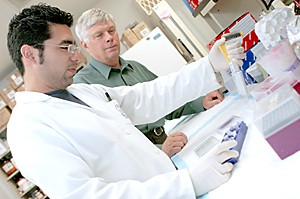The U.S. Environmental Protection Agency recently granted the UA $1.75 million to fund a U.S. and Mexico Binational Center for Environmental Science and Toxicology. In addition, the state of Arizona is providing more than $420,000 in funding for the project, according to the EPA.
The Binational center will involve a collaboration of UA scientists from six UA colleges and Mexican scientists from 10 universities in Mexico that will focus on four areas of research, said Emily Pimentel, EPA U.S.-Mexico Coordinator for the Waste Management Project Office.
“”The UA had an existing center (UA’s National Institute of Environmental Health Sciences – Superfund Basic Research Program), which was focused on evaluating impacts associated with industrialized contamination,”” Pimentel said. “”The center is now creating a U.S.-Mexico focus to address issues that are potentially trans-boundary related contamination.””
The center will also provide Mexican doctoral students of environmental science, engineering and toxicology the opportunity to establish six doctorates, three post-doctoral fellowships and multiple study opportunities at the UA, said Jim Fields, a professor at the department of chemical and environmental engineering.
“”We want to have scientists come up from Mexico and do one of two things,”” said Jay Gandolfi, an assistant dean for research in the College of Pharmacy. “”Either train with us in our graduate programs and return to Mexico, or have them already in a graduate program in Mexico and come train with us in the middle, then go back to complete their degree.””
The project will focus on two general environmental pollutions: arsenic metals from mining tailings and organic waste in landfills, Gandolfi said.
The UA will conduct four collaborative projects with Mexico, two on health and two on environmental science, and will apply the results of the studies to both U.S. and Mexican problems, Gandolfi said.
“”The real mission is to increase the education, the training and the skills of young Mexican professionals or graduate students so that they can go back and become leaders and help tackle some problems along the border,”” Fields said.
This program will increase U.S.-Mexico collaboration so that each nation is better prepared to solve environmental and human health risks in the border region.
EPA regional administrator for Pacific Southwest region
The idea for a Binational Center was finalized after a Memorandum of Understanding was signed between the UA and Mexico’s Science and Education Ministry in 2003, Fields said.
The center comes when, statistically, more than 2,700 border industries are involved in uncontrolled disposal of large amounts of hazardous waste; it is estimated that Mexican Border States generate more than 12.5 million tons of hazardous waste.
“”Border communities, particularly children, have a higher incidence of health problems,”” said Wayne Nastri, the EPA’s regional administrator for the Pacific Southwest region in a news release. “”This program will increase U.S.-Mexico collaboration so that each nation is better prepared to solve environmental and human health risks in the border region.””
The UA will coordinate with the EPA and SEMARNAT, Mexico’s environmental agency, to assure the center meet Border 2012 cleanup goals, according to the news release. Border 2012 is a U.S.-Mexico plan to protect the environment and public health along the 2,000-mile border region.
“”The idea is really to create professionals in Mexico who are able to handle and address the problems for themselves,”” Pimentel said. “”That is in importance to the U.S. because if there is contamination on the Mexican side, it’s very likely it could get the U.S. side.””
An estimated 12 million citizens of Mexico and the U.S. live along the southern border.
The EPA said the program will concentrate on decreasing air, water and waste pollution, and lower exposure risk to pesticides and other chemicals.









